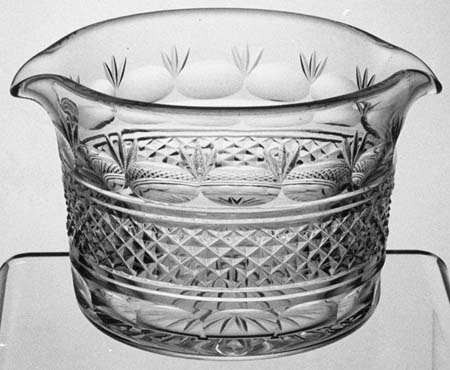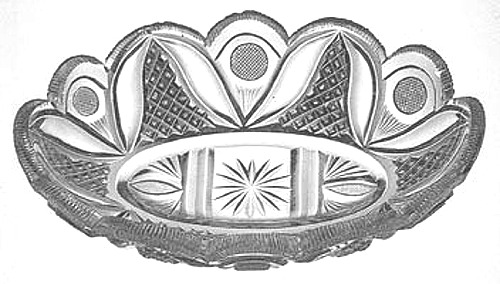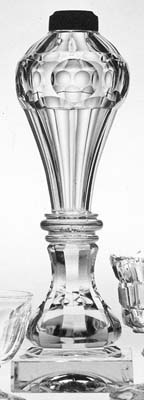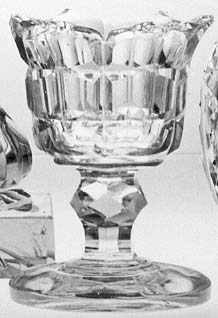
Wine glass cooler. c1810-c1835. Two lips. Origin unknown, possibly English. Neo-classical pattern with a horizontal band of sharp diamonds on the body framed with two prismatic rings and two rows of bullseyes ("almonds"), the uppermost one with 3-ribbed fans ("sprigs"). Star-cut base. D = 6" (15.2 cm), H = 3.75" (9.5 cm). Sold for $50 in 1991.

Compote. c1830-c1850. Factory and country of origin unknown, possibly Irish. Underside of foot, with its 8-pt hobstar, in an early representation, is also shown. D = 8.5" (21.6 cm), H = 5.5" (14.0 cm), wt = 3 lb (1.2 kg). Sold for $100 in 1991.


Covered Sugar Bowl. c1840-c1860. The cut-glass pattern on this sugar bowl must have been a popular one, judging from the number of items that are found today; items such as dishes, lamp fonts, spooners, and celery vases. A pair of pitchers cut in this pattern by the Jersey Glass Company and dated 1830-1850 are shown in an article about this company by Spillman and Frelinghuysen (see note 1) who do not identify the pattern's name which is sometimes referred to as "Linked Punties" or "Spiked Argus". It was a popular pattern and was probably cut by more than one company. 16-pt star on foot. H = 9.25" (23.5 cm), max D = 5" (12.7 cm), wt = 3 lb (1.4 kg). Sold for $125 in 1990.

Bowl. c1830-c1840. Unidentified pattern by the Jersey Glass Company, Jersey City, NJ. L = 7.8" (19.7 cm). (Image: Spillman and Franz 1990, p. 24; Corning Museum of Glass, acc. no. 71.4.113.)

Tray. c1830-c1850. Unidentified pattern by an unknown company. Possibly Bohemian, mid-nineteenth century. L = 14" (35.6 cm), W = 8.75" (22.2 cm), H = 3" (7.6 cm), wt = 4.2 lb (1.9 kg) (Image: Internet). Additional images of this item are available in Appendix B.

LEFT: Fluid Lamp. c1840-c1860. Blown font, cut with flutes and a row of bullseyes. Attached by wafer to solid base: molded glass, trimmed at the wheel. Large pontil appears to have been part of the mold. One of a pair, obtained at the auction of Bertha Tripp's effects in Middleboro, MA, 12 May 1984. H = 10.75" (27.3 cm). Side of foot = 3.25" (8.2 cm), wt = 3 lb (1.4 kg). Sold for $180 in 1988. The second lamp has a one-inch crack at its metal collar. It sold for $100 in 1990. RIGHT: Standing Salt. c1835-c1855. Thick, blown blank. Body cut in an early version of the Block pattern. Ogee ("bracket") rim. H = 4" (10.2 cm), foot D = 2.75" (7.0 cm). Sold for $75 in 1990.


Covered Urns, c1830-c1850 and Compotes, c1904. Please see the foreign1.htm file in Part 1 for examples of these items that are often offered for sale as American-made.
NOTE:
1. Spillman, J. S. and A. C. Frelinghausen, 1990: The Dummer glass and ceramic factories in Jersey City, New Jersey, The Magazine Antiques, March 1990, pp. 706-17.
Reference: [Havens, J. M.], 1988: Anglo-American cut glass discoveries (part 2), The Hobstar, Vol. 10, No. 6, pp. 12-13 (Mar).
Updated 15 Jun 2007